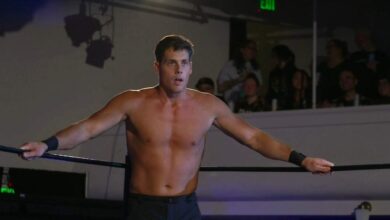Do we really need to ‘take on’ Tyson again?
Unless you live under a rock (or aren’t a wrestling fan), you probably know that Mike Tyson—“The Sound and the Fury,” “Bite Fight” Mike Tyson—recently joined the ranks of All Elite Wrestling. He presented the TNT Championship at Double or Nothing 2, and appeared to start a new storyline with Chris Jericho on the May 27 episode of AEW Dynamite.
To quote John Oliver: why this particular asshole?
Have we all collectively decided to just forgive everything that Mike Tyson has done? Or have we simply forgotten?
Robin Givens & Fire and Fear
Robin Givens is a model and actress who began dating Tyson in 1987. They married in February 1988 and divorced a year later. The marriage was publicly tumultuous—at the time, Givens was starring on the ABC sitcom Head of Class, and Tyson was a well-known athlete.
The pair even sat down for a strange joint interview with Barbara Walters on 20/20 in September 1988. In this interview, Givens says that life with Tyson was “torture, pure hell, worse than anything I could possibly imagine.” She claims physical abuse began before they were married.
Tyson denies the abuse. However, in the 1989 book Fire and Fear: The Inside Story of Mike Tyson, he allegedly discusses a night in which he punched Givens so hard, “She flew backwards, hitting every wall in the apartment.” According to this book, which was written by fellow fighter Jose Torres, Tyson says, “That was the best punch I’ve ever thrown in my entire life.”
Tyson has said in his autobiography that Fire and Fear is “filled with inaccuracies.” However, in 2009, he made a joke on Oprah about “socking” Givens. Because joking about spousal abuse you insist never happened, despite written claims it did, is hilarious and totally appropriate for daytime television.
In Fire and Fear, Torres also claims that Tyson said, “I like to hurt women when I make love to them…It gives me pleasure.” Tyson also claims this is inaccurate and that, “Torres is a pervert.” And yet, subsequent events would call into question exactly who was the pervert.
Givens would go on to serve as the spokesperson for the National Domestic Violence Hotline for several years. She continues to appear in film and television.
Desiree Washington & Virginia Foster
Desiree Washington was only 18 years old when she met Mike Tyson in 1991. The then-Miss Black Rhode Island was dropped off by Tyson’s limo driver at an Indianapolis hotel, where she was violently raped by Tyson. This limo driver, Virginia Foster, would later testify that the girl returned to the limo “like she may have been in a state of shock…dazed, disoriented. She seemed scared.”
What the jury didn’t hear, according to Bad Intentions: The Mike Tyson Story, was that Tyson also assaulted Foster that night, grabbing and kissing her before exposing himself to her. The 44-year-old school counselor was able to escape before the assault progressed further; later that night, he raped Washington in the same room.
About 26 hours after the rape, Washington sought medical attention at Methodist Hospital, where she was seen by Dr. Thomas Richardson. Richardson later testified that he found two vaginal abrasions consistent with “forced or very hard intercourse.” Dr. James Akin of the Indiana University School of Medicine concurred with Richardson’s findings, stating that the abrasions were “incredibly unlikely to happen in consensual sex.”
Tyson was arrested in July 1991 and claimed that everything that occurred between them was consensual. He was convicted of rape on Feb. 10, 1992, after just 10 hours of jury deliberation.
Unfortunately, as is the case in so many rape convictions, the punishment did not fit the crime. Tyson was sentenced to six years, but served less than three, all of which were served in the Indiana Youth Center (now the Plainfield Correctional Facility), despite the fact that he was 25 years old when he was sentenced.
One justice: he had to register as a Tier II sex offender under federal law.
1995 to Today
The rest is a familiar story – convicted rapist fades into obscurity and is universally condemned by the organizations that once heralded him as a hero—
Oh, wait! This is the United States, not a realm of logic and principle.
No, pretty immediately Tyson stepped back into his boxing career. In fact, according to the New York Times, his comeback fight against Peter McNeeley grossed more than $96 million worldwide, $63 million of which was generated in U.S. This set a U.S. record for pay-per-view television. Showtime Entertainment estimated that the fight was purchased by more than 1.5 million homes. America, am I right?
The message was clear: we don’t care what you did. As long as you continue to entertain us, we will continue to pay you to do so.
Tyson continued to have a storied boxing career for ten years, retiring in 2005. This wasn’t without ups and downs, but it landed him on many “Greatest Heavyweights of All Time” and “Greatest Punchers of All Time” (no irony) lists. He was inducted to the International Boxing Hall of Fame in 2011.
In the last fifteen years, Tyson has been arrested multiple times for drug possession and driving under the influence. He has spoken openly about struggles with sobriety, attempts at veganism, and his relationship with religion.
How does this person fit into the character that has been developed in All Elite Wrestling?
All Elite Wrestling
All Elite Wrestling (AEW) is a professional wrestling company founded by Tony Khan, son of Jacksonville Jaguars owner and entrepreneur Shahid Khan, in 2019. The promotion features “The American Nightmare” Cody Rhodes, Matt and Nick Jackson (“The Young Bucks”), and Kenny Omega as executive vice presidents and in-ring talent, operating under the stable moniker “The Elite.”
AEW is considered the first major promotion to take on the monopolizing World Wrestling Entertainment (WWE) since 2001 with its weekly show, AEW Dynamite.
From its inception, AEW has proclaimed to be “for everyone.” This has applied to fans as well as the talent—AEW has contracted wrestlers like Nyla Rose, the first openly transgender wrestler to sign (and win a title) with a major promotion, and Sonny Kiss, an openly gay wrestler whose nontraditional and flamboyant style draws from his experience as a dancer. AEW also featured Dustin Thomas, a bilateral amputee wrestler, in their first battle royal on Double or Nothing (2019).
The company’s top wrestlers also regularly demonstrate progressive attitudes, both in and out of the ring. In an interview with Jonathan Snowden of Bleacher Report, Omega said, “I’m trying to open up the world to what wrestling can be and show there is no limitation to what wrestling can be.”
Brandi Rhodes, AEW Chief Brand Officer and in-ring talent, has also been a vocal supporter of the promotion’s partnership with KultureCity, a nonprofit that provides education for sensory accessibility and inclusion.
Where does Mike Tyson and his turbulent history fit into all this?
Trying to Understand
This isn’t the first time that Tyson has set foot in a wrestling ring—in the fallout from the infamous “Bite Fight” with Evander Holyfield, Tyson’s boxing license was suspended for a year in a unanimous decision by the Nevada State Athletic Commission.
This opened Tyson’s schedule for a temporary stint on Monday Night RAW—and just in time. Capitalizing on Tyson’s star power, McMahon offered the heavyweight a reported $3.5 million contract to join the then-WWF, at least until his boxing license was reinstated.
Tyson made his debut on the RAW following the 1998 Royal Rumble, immediately feuding with Stone Cold Steve Austin and helping to seal the fate of World Championship Wrestling—the promotion founded by Ted Turner, owner of TNT.
Over the years, Tyson has made a smattering of appearances in WWE. He served as the enforcer for the match between Stone Cold and Shawn Michaels at Wrestlemania 14 in 1998. As Jericho referenced in his promo on May 27, he also appeared in 2010 as Jericho’s tag team partner, only to turn on Jericho and secure the win for D-Generation X, a rival tag team led by Michaels and Triple H. Tyson was inducted into the WWE Hall of Fame Celebrity Wing in 2012.
Evidently, he didn’t stop loving wrestling eight years ago. According to Tony Khan, Tyson was in attendance at last year’s Double or Nothing. Khan has been building a relationship with Tyson ever since, leading to his involvement at DON2 and now on Dynamite.
And there is no questioning Tyson’s impact—according to Uproxx, the May 27 episode of Dynamite had 827,000 live cable viewers. Compared to the record low of 654,000 viewers of the May 20 go-home show, that is a stark improvement.
Was that all the Tyson effect? I doubt it—the show after a big PPV, especially one as successful as DON2 (which saw at least 100,000 buys according to Dave Meltzer, with possibly up to 120,000 buys), is usually well-watched. But there is no doubt that having a recognizable name like Tyson on the card helped garner interest.
Let’s set aside all of Tyson’s problems—the rape conviction and misogyny, the history of substance abuse and DUIs, his violent record with opponents. The segment with Jericho was just bad.
Jericho was in prime promo mode—he’s truly never been better on the mic—but Tyson and his cadre of fellow fighters (and one strange raccoon of a man) didn’t seem to know what to do. Had they not rehearsed this? And then the shirt rip and flex—it was like he forgot this was a wrestling segment, which is supposed to be a performance, and was seriously getting amped up to fight this guy talking trash about him.
Except Jericho wasn’t talking trash about Tyson, the person—he was talking trashing about Tyson, the character. Does Tyson not know the difference?
Maybe AEW doesn’t. Because when they take on Mike Tyson, they aren’t taking on some mythic version of him—they are taking on the real man, and all the baggage that entails.
Inviting someone like Tyson into the fold of AEW—not just as a special guest for one show, as they did with Bret Hart and the reveal of the AEW World Championship Belt—tarnishes the inclusive reputation that AEW has worked to build in the last year. It hinders any work they hope to do in concurrent programs because the specter of Tyson will always loom in the background or next segment. His presence on their roster and in their locker room damages the trust The Elite have worked so hard to foster with fans, particularly those impacted by sexual and/or domestic violence.
I suspect those in AEW are not thinking about it this way, or else they wouldn’t have brought Tyson in to begin with. So, what are they thinking?
Perhaps they are simply using the Tyson name recognition to climb the media ladder, particularly in a time when wrestling is facing increasing pressure to innovate in the face of COVID-19.
But my impression is that, when climbing a ladder, you often don’t get what you want.
But maybe I just watch too much wrestling.




